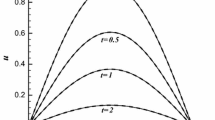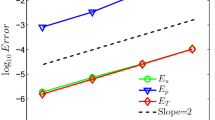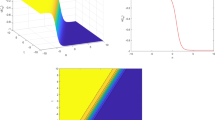Abstract
In this paper, a lattice Boltzmann model for the three-dimensional complex Ginzburg–Landau equation is proposed. The multi-scale technique and the Chapman–Enskog expansion are used to describe higher-order moments of the complex equilibrium distribution function and a series of complex partial differential equations. The modified partial differential equation of the three-dimensional complex Ginzburg–Landau equation with the third order truncation error is obtained. Based on the complex lattice Boltzmann model, some motions of the stable scroll, such as the scroll wave with a straight filament, scroll ring, and helical scroll are simulated. The comparisons between results of the lattice Boltzmann model with those obtained by the alternative direction implicit scheme are given. The numerical results show that this model can be used to simulate the three-dimensional complex Ginzburg–Landau equation.














Similar content being viewed by others
References
Higuera, F.J., Succi, S., Benzi, R.: Lattice gas dynamics with enhanced collisions. Europhys. Lett. 9, 345–349 (1989)
Higuera, F.J., Jimènez, J.: Boltzmann approach to lattice gas simulations. Europhys. Lett. 9, 663–668 (1989)
Qian, Y.H., d’humieres, D., Lallemand, P.: Lattice BGK model for Navier–Stokes equations. Europhys. Lett. 17(6), 479–484 (1992)
Chen, H.D., Chen, S.Y., Matthaeus, M.H.: Recovery of the Navier–Stokes equations using a lattice Boltzmann gas method. Phys. Rev. A 45, 5339–5342 (1992)
Benzi, R., Succi, S., Vergassola, M.: The lattice Boltzmann equations: theory and applications. Phys. Rep. 222, 145–197 (1992)
Chen, S.Y., Doolen, G.D.: Lattice Boltzmann method for fluid flows. Annu. Fluid Mech. 3, 314–322 (1998)
Succi, S.: The Lattice Boltzmann Equation for Fluid Dynamics and Beyond. Oxford University Press, New York (2001)
Frisch, U., Hasslacher, B., Pomeau, Y.: Lattice gas automata for the Navier–Stokes equations. Phys. Rev. Lett. 56, 1505–1508 (1986)
Wolfram, S.: Cellular automaton fluids 1: basic theory. J. Stat. Phys. 45, 471–518 (1986)
Shan, X.W., Chen, H.D.: Lattice Boltzmann model of simulating flows with multiple phases and components. Phys. Rev. E 47, 1815–1819 (1993)
Luo, L.S.: Theory of the lattice Boltzmann method: lattice Boltzmann method for nonideal gases. Phys. Rev. E 62, 4982–4996 (2000)
Premnath, K.N., Abraham, J.: Three-dimensional multi-relaxation lattice Boltzmann models for multiphase flows. J. Comput. Phys. 224, 539–559 (2007)
Ladd, A.: Numerical simulations of particle suspensions via a discretized Boltzmann equation, part 2. Numerical results. J. Fluids Mech. 271, 311–339 (1994)
Filippova, O., Hanel, D.: Lattice Boltzmann simulation of gas-particle flow in filters. Comput. Fluids 26, 697–712 (1997)
Chen, S.Y., Chen, H.D., Martinez, D., et al.: Lattice Boltzmann Model for simulation of magneto-hydrodynamics. Phys. Rev. Lett. 67, 3776–3779 (1991)
Vahala, L., Vahala, G., Yepez, J.: Lattice Boltzmann and quantum lattice gas representations of one-dimensional magnetohydrodynamic turbulence. Phys. Lett. A 306, 227–234 (2003)
Vahala, G., Keating, B., Soe, M., et al.: MHD turbulence studies using lattice Boltzmann algorithms. Commun. Comput. Phys. 4, 624–646 (2008)
Dawson, S.P., Chen, S.Y., Doolen, G.D.: Lattice Boltzmann computations for reaction–diffusion equations. J. Chem. Phys. 98, 1514–1523 (1993)
Yepez, J.: Quantum lattice-gas model for the diffusion equation. Int. J. Mod. Phys. C 12, 1285–1303 (2001)
Berman, G.P., Ezhov, A.A., Kamenev, D.I., et al.: Simulation of the diffusion equation on a type-II quantum computer. Phys. Rev. A 66, 012310 (2002)
Cali, A., Succi, S., Cancelliere, A., et al.: Diffusion and hydrodynamic dispersion with the lattice Boltzmann method. Phys. Rev. A 45, 5771–5774 (1992)
Blaak, R., Sloot, P.M.: Lattice dependence of reaction–diffusion in lattice Boltzmann modeling. Comput. Phys. Commun. 129, 256–266 (2000)
Succi, S., Foti, E., Higuera, F.J.: 3-Dimensional flows in complex geometries with the lattice Boltzmann method. Europhys. Lett. 10, 433–438 (1989)
Sun, C.H.: Lattice-Boltzmann model for high speed flows. Phys. Rev. E 58, 7283–7287 (1998)
Yan, G.W., Chen, Y.S., Hu, S.X.: Simple lattice Boltzmann model for simulating flows with shock wave. Phys. Rev. E 59, 454–459 (1999)
Qu, K., Shu, Q., Chew, Y.T.: Alternative method to construct equilibrium distribution function in lattice-Boltzmann method simulation of inviscid compressible flows at high Mach number. Phys. Rev. E 75, 036706 (2007)
Gan, Y.B., Xu, A.G., Zhang, G.C., et al.: Two-dimensional lattice Boltzmann model for compressible flows with high Mach number. Phys. A 387, 1721–1732 (2008)
Mendoza, M., Boghosian, B.M., Herrmann, H.J., Succi, S.: Fast lattice Boltzmann solver for relativistic hydrodynamics. Phys. Rev. Lett. 105, 014502 (2010)
Nash, R.W., Adhikari, R., Tailleur, J., Cates, M.E.: Run-and-tumble particles with hydrodynamics: sedimentation, trapping, and upstream swimming. Phys. Rev. Lett. 104, 258101 (2010)
Benzi, R., Chibbaro, S., Succi, S.: Mesoscopic lattice Boltzmann modeling of flowing soft systems. Phys. Rev. Lett. 102, 026002 (2009)
Li, H., Ki, H.: Lattice-Boltzmann simulation of laser interaction with weakly ionized helium plasmas. Phys. Rev. E 82, 016703 (2010)
Suga, K., Takenaka, S., Ito, T., et al.: Evaluation of a lattice Boltzmann method in a complex nanoflow. Phys. Rev. E 82, 016701 (2010)
Kekre, R., Butler, J.E., Ladd, A.: Comparison of lattice-Boltzmann and Brownian-dynamics simulations of polymer migration in confined flows. Phys. Rev. E 82, 011802 (2010)
Chopard, B., Luthi, P.O.: Lattice Boltzmann computations and applications to physics. Theor. Comput. Sci. 217, 115–130 (1999)
Yan, G.W.: A lattice Boltzmann equation for waves. J. Comput. Phys. 161, 61–69 (2000)
Zhang, J.Y., Yan, G.W., Shi, X.B.: Lattice Boltzmann model for wave propagation. Phys. Rev. E 80, 026706 (2009)
Kwon, Y.W., Hosoglu, S.: Application of lattice Boltzmann method, finite element method, and cellular automata and their coupling to wave propagation problems. Comput. Struct. 86, 663–670 (2008)
Yepez, J.: Quantum lattice-gas model for the Burgers equation. J. Stat. Phys. 107, 203–224 (2002)
Yepez, J.: Open quantum system model of the one-dimensional Burgers equation with tunable shear viscosity. Phys. Rev. A 74, 042322 (2006)
Velivelli, A.C., Bryden, K.M.: Parallel performance and accuracy of lattice Boltzmann and traditional finite difference methods for solving the unsteady two-dimensional Burger’s equation. Phys. A 362, 139–145 (2006)
Vahala, G., Yepez, J., Vahala, L.: Quantum lattice gas representation of some classical solitons. Phys. Lett. A 310, 187–196 (2003)
Yan, G.W., Zhang, J.Y.: A higher-order moment method of the lattice Boltzmann model for the Korteweg–de Vries equation. Math. Comput. Simul. 79, 1554–1565 (2009)
Zhang, J.Y., Yan, G.W.: A lattice Boltzmann model for the Korteweg–de Vries equation with two conservation laws. Comput. Phys. Commun. 180, 1054–1062 (2009)
Yan, G.W., Yuan, L.: Lattice Bhatnagar–Gross–Krook model for the Lorenz attractor. Phys. D 154, 43–50 (2001)
Zhou, J.G.: Lattice Boltzmann Methods for Shallow Water Flows. Springer, Berlin (2000)
Ginzburg, I.: Variably saturated flow described with the anisotropic lattice Boltzmann methods. J. Comput. Fluids 25, 831–848 (2006)
Melchionna, S., Succi, S.: Lattice Boltzmann–Poisson method for electrorheological nanoflows in ion channels. Comput. Phys. Commun. 169, 203–206 (2005)
Capuani, F., Pagonabarraga, I., Frenkel, D.: Discrete solution of the electrokinetic equations. J. Chem. Phys. 121, 973–986 (2004)
Hirabayashi, M., Chen, Y., Ohashi, H.: The lattice BGK model for the Poisson equation. JSME Int. J. Ser. B 44, 45–52 (2001)
Chai, Z.H., Shi, B.C.: A novel lattice Boltzmann model for the Poisson equation. Appl. Math. Model. 32, 2050–2058 (2008)
Wang, M.R., Wang, J.K., Chen, S.Y.: Roughness and cavitations effect on electro-osmotic flows in rough microchannels using the lattice Poisson–Boltzmann methods. J. Comput. Phys. 226, 836–851 (2007)
Wang, H.M., Yan, G.W., Yan, B.: Lattice Boltzmann model based on the rebuilding-divergency method for the Laplace equation and the Poisson equation. J. Sci. Comput. 46, 470–484 (2010)
Succi, S., Benzi, R.: Lattice Boltzmann equation for quantum mechanics. Phys. D 69, 327–332 (1993)
Succi, S.: Lattice quantum mechanics: an application to Bose–Einstein condensation. Int. J. Mod. Phys. C 9, 1577–1585 (1998)
Zhong, L.H., Feng, S.D., Dong, P., Gao, S.T.: Lattice Boltzmann schemes for the nonlinear Schrödinger equation. Phys. Rev. E 74, 036704 (2006)
Zhang, J.Y., Yan, G.W.: A lattice Boltzmann model for the nonlinear Schrödinger equation. J. Phys. A 40, 10393–10405 (2007)
Shi, B.C.: Lattice Boltzmann simulation of some nonlinear complex equations. Lect. Notes Comput. Sci. 4487, 818–825 (2007)
Yepez, J., Vahala, G., Vahala, L.: Vortex–antivortex pair in a Bose–Einstein condensate. Eur. Phys. J. Spec. Top. 171, 9–14 (2009)
Yepez, J., Vahala, G., Vahala, L.: Twisting of filamentary vortex solitons demarcated by fast Poincaré recursion. Proc. SPIE 7342, 73420M (2009)
Yepez, J., Vahala, G., Vahala, L.: Lattice quantum algorithm for the Schrödinger wave equation in 2 + 1 dimensions with a demonstration by modeling soliton instabilities. Quantum Inf. Process. 4, 457–469 (2005)
Vahala, G., Vahala, L., Yepez, J.: Inelastic vector soliton collisions: a lattice-based quantum representation. Philos. Trans. R. Soc. A 362, 1677–1690 (2004)
Vahala, G., Vahala, L., Yepez, J.: Quantum lattice representations for vector solitons in external potentials. Phys. A 362, 215–221 (2006)
Succi, S.: Numerical solution of the Schrödinger equation using discrete kinetic theory. Phys. Rev. E 53, 1969–1975 (1996)
Yepez, J., Boghosian, B.: An efficient and accurate quantum lattice-gas model for the many-body Schrödinger wave equation. Comput. Phys. Commun. 146, 280–294 (2002)
Palpacelli, S., Succi, S., Spigler, R.: Ground-state computation of Bose–Einstein condensates by an imaginary-time quantum lattice Boltzmann scheme. Phys. Rev. E 76, 036712 (2007)
Palpacelli, S., Succi, S.: Quantum lattice Boltzmann simulation of expanding Bose–Einstein condensates in random potentials. Phys. Rev. E 77, 066708 (2008)
Yepez, J.: Relativistic path integral as a lattice-based quantum algorithm. Quantum Inf. Process. 4, 471–509 (2005)
Zhang, J.Y., Yan, G.W.: Lattice Boltzmann model for the complex Ginzburg–Landau equation. Phys. Rev. E 81, 066705 (2010)
Aranson, I.S., Kramer, L.: The world of the complex Ginzburg–Landau equation. Rev. Mod. Phys. 74, 99–143 (2002)
Kuramoto, Y.: Chemical Oscillations, Waves, and Turbulence. Springer, Berlin (1984)
Winfree, A.T.: Spiral waves of chemical activity. Science 175, 634–636 (1972)
Fewo, S.I., Kofane, T.C.: A collective variable approach for optical solitons in the cubic–quintic complex Ginzburg–Landau equation with third-order dispersion. Opt. Commun. 281, 2893–2906 (2008)
Porsezian, K., Murali, R., Malomed, B.A., et al.: Modulational instability in linearly coupled complex cubic–quintic Ginzburg–Landau equations. Chaos Solitons Fractals 40, 1907–1913 (2009)
Jiang, M.X., Wang, X.N., Ouyang, Q., et al.: Spatiotemporal chaos control with a target wave in the complex Ginzburg–Landau equation system. Phys. Rev. E 69, 056202 (2004)
Zhang, S.L., Bambi, H., Zhang, H.: Analytical approach to the drift of the tips of spiral waves in the complex Ginzburg–Landau equation. Phys. Rev. E 67, 016214 (2003)
Gong, Y.F., Christini, D.J.: Antispiral waves in reaction–diffusion systems. Phys. Rev. Lett. 90, 088302 (2003)
Brusch, L., Nicola, M.E., Bär, M.: Comment on antispiral waves in reaction–diffusion systems. Phys. Rev. Lett. 92, 89801 (2004)
Kapral, R., Showalter, K.: Chemical Waves and Patterns. Kluwer, Dordrecht (1995)
Winfree, A.T.: When Time Breaks Down. Princeton University Press, NJ (1987)
Berenfeld, O., Wellner, M., Jalife, J., Pertsov, A.M.: Shaping of a scroll wave filament by cardiac fibers. Phys. Rev. E 63, 061901 (2001)
Morgan, S.W., Biktasheva, I.V., Biktashev, V.N.: Control of scroll-wave turbulence using resonant perturbations. Phys. Rev. E 78, 046207 (2008)
Panfilov, A.V., Hogeweg, P.: Scroll breakup in a three-dimensional excitable medium. Phys. Rev. E 53, 1740–1743 (1996)
Henry, H., Hakim, V.: Linear stability of scroll waves. Phys. Rev. Lett. 85, 5328–5331 (2000)
Luengviriya, C., Hauser, M.J.B.: Stability of scroll ring orientation in an advective field. Phys. Rev. E 77, 056214 (2008)
Henry, H., Hakim, V.: Scroll waves in isotropic excitable media: linear instabilities, bifurcations, and restabilized states. Phys. Rev. E 65, 046235 (2002)
Henry, H.: Spiral wave drift in an electric field and scroll wave instabilities. Phys. Rev. E 70, 026204 (2004)
Wang, C., Wang, S., Zhang, C., Ouyang, Q.: Spontaneous scroll ring creation and scroll instability in oscillatory medium with gradients. Phys. Rev. E 72, 066207 (2005)
Luengviriya, C., Storb, U., Lindner, G., et al.: Scroll wave instabilities in an excitable chemical medium. Phys. Rev. Lett. 100, 148302 (2008)
Aranson, I., Mitkov, I.: Helicoidal instability of a scroll vortex in three-dimensional reaction–diffusion systems. Phys. Rev. E 58, 4556–4559 (1998)
Qu, Z., Xie, F., Garfinkel, A.: Diffusion-induced vortex filament instability in 3-dimensional excitable media. Phys. Rev. Lett. 83, 2668–2671 (1999)
Aranson, I.S., Bishop, A.R., Kramer, L.: Dynamics of vortex lines in the three-dimensional complex Ginzburg–Landau equation: instability, stretching, entanglement, and helices. Phys. Rev. E 57, 5276–5286 (1998)
Nam, K., Ott, E., Guzdar, P.N., Gabbay, M.: Stability of spiral wave vortex filament with phase twists. Phys. Rev. E 58, 2580–2585 (1998)
Wellner, M., Berenfeld, O., Pertsov, A.M.: Predicting filament drift in twisted anisotropy. Phys. Rev. E 61, 1845–1850 (2000)
Setayeshgar, S., Bernoff, A.J.: Scroll waves in the presence of slowly varying anisotropy with application to the heart. Phys. Rev. Lett. 88, 028101 (2002)
Verschelde, H., Dierckx, H., Bernus, O.: Covariant stringlike dynamics of scroll wave filaments in anisotropic cardiac tissue. Phys. Rev. Lett. 99, 168104 (2007)
Vinson, M., Pertsov, A.: Dynamics of scroll rings in a parameter gradient. Phys. Rev. E 59, 2764–2771 (1999)
Gabbay, M., Ott, E., Guzdar, P.N.: The dynamics of scroll wave filaments in the complex Ginzburg–Landau equation. Phys. D 118, 371–395 (1998)
ten Tusscher, K.H.W.J., Panfilov, A.V.: Eikonal formulation of the minimal principle for scroll wave filaments. Phys. Rev. Lett. 93, 108106 (2004)
Dierckx, H., Bernus, O., Verschelde, H.: A geometric theory for scroll wave filaments in anisotropic excitable media. Phys. D 238, 941–950 (2009)
Alonso, S., Panfilov, A.V.: Negative filament tension at high excitability in a model of cardiac tissue. Phys. Rev. Lett. 100, 218101 (2008)
Gabbay, M., Ott, E., Guzdar, P.N.: Motion of scroll wave filaments in the complex Ginzburg–Landau equation. Phys. Rev. Lett. 78, 2012–2015 (1997)
Alonso, S., Kähler, R., Mikhailov, A.S., Sagués, F.: Expanding scroll rings and negative tension turbulence in a model of excitable media. Phys. Rev. E 70, 056201 (2004)
Luengviriya, C., Müller, S.C., Hauser, M.J.B.: Reorientation of scroll rings in an advective field. Phys. Rev. E 77, 015201(R) (2008)
Bray, M.A., Wikswo, J.P.: Interaction dynamics of a pair of vortex filament rings. Phys. Rev. Lett. 90, 238303 (2003)
Bánsági, T., Steinbock, O.: Nucleation and collapse of scroll rings in excitable media. Phys. Rev. Lett. 97, 198301 (2006)
Wu, Y., Qiao, C., Ouyang, Q., Wang, H.: Control of spiral turbulence by periodic forcing in a reaction–diffusion system with gradients. Phys. Rev. E 77, 036226 (2008)
Alonso, S., Sancho, J.M., Sagués, F.: Suppression of scroll wave turbulence by noise. Phys. Rev. E 70, 067201 (2004)
Wu, N.J., Zhang, H., Ying, H.P., et al.: Suppression of winfree turbulence under weak spatiotemporal perturbation. Phys. Rev. E 73, 060901(R) (2006)
Briscolini, M., Santangelo, P., Succi, S., Benzi, R.: Extended self-similarity in the numerical simulation of three-dimensional homogeneous flows. Phys. Rev. E 50, R1745–R1747 (1994)
Barkley, D.: A model for fast computer simulation of waves in excitable media. Phys. D 49, 61–70 (1991)
Rusakov, A., Medvinsky, A.B., Panfilov, A.V.: Scroll waves meandering in a model of an excitable medium. Phys. Rev. E 72, 022902 (2005)
Chapman, S., Cowling, T.G.: The Mathematical Theory of Non-uniform Gases. Cambridge University Press, Cambridge (1970)
Acknowledgments
This work is supported by the National Nature Science Foundation of China (Grant No. 11272133), and the China Postdoctoral Science Foundation (No. 2011M500002). We would like to thank Prof. Chen Shiyi and Prof. Wang Moran for their many helpful suggestions.
Author information
Authors and Affiliations
Corresponding author
Appendix
Appendix
According to Eqs. (24a, 24b), we have
Denote
and
Assuming that the additional distribution \(\phi ^{p}\) meets the following moments
We can obtain
then
According to Eq. (13), the conservation law in time scale \(t_0\) can be obtained as
Also, we have
Summing over Eq. (14), then
According to the Eqs. (35), (36) and (39), we have
Taking \((13)+(14)\times \varepsilon \) and summing over \(\alpha \), we have
And other equations are
Summing over Eq. (15), then
According to the moments of the equilibrium distribution function, we have
According to Eqs. (13), (37), (40) and (42), we obtain
Taking \((13) + (14)\times \varepsilon + (15)\times \varepsilon ^{2}\) and summing over \(\alpha \), we have
and
Summing over Eq. (16), then
According to the moments of the equilibrium distribution, we have
According to Eqs. (37), (38), (42) and (44), we have
Taking \((13) + (14)\times \varepsilon + (15)\times \varepsilon ^{2}+ (16)\times \varepsilon ^{3}\) and summing over \(\alpha \), we have
where
Equation (62) is the complex Ginzburg–Landau equation with the third-order accuracy of truncation error and without error rebound effect, it is
Rights and permissions
About this article
Cite this article
Zhang, J., Yan, G. Three-Dimensional Lattice Boltzmann Model for the Complex Ginzburg–Landau Equation. J Sci Comput 60, 660–683 (2014). https://doi.org/10.1007/s10915-013-9811-z
Received:
Revised:
Accepted:
Published:
Issue Date:
DOI: https://doi.org/10.1007/s10915-013-9811-z




